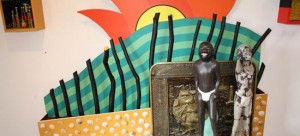
The well-known Sydney painter, photographer, cartoonist and didgeridoo performer, Adam says the idea for the exhibition, called Are We There Yet? came from conducting art workshops in Goulburn Jail last year.
“The workshops were organised by Djon Mundine and I was working with about eight amazing artists in there. It hit me like a ton of bricks that these lads inside were producing deadly art, but that all of that energy was locked up – that if one in four blackfellas are locked up on this continent then the spirit of the place is meeting a rapid demise,” he says.
“That’s how I got the idea of making an artwork that was a stylised prison cell and barcode. I wanted to look at a creative way of telling a story about where we are as a society.”
The exhibition features works made out of recycled timber and refuse and other pieces collected from the streets that people put our for council pickups. Mr Hill says in making the art out of these materials he was also addressing his environmental footprint.
“I decided to look at a different avenue of producing art – not on canvass – I started looking at what people chuck out every fortnight for the council pickups,” he says.
“I introduced a couple of metaphors – the found object is often a table top or a discarded old door and I am using that as a canvass to mount other parts on. That becomes the basis for the artwork. Then I add eucalypt branches, sourced from trees that have fallen in storms. I want to represent the spirituality of the land by using the gorgeous organic shape of the branches. The underlying metaphor is to create an attractive looking prison cell.”
Fellow artist and actor Max Cullen officially opened the exhibition, recalling the story of a playwright who came into a jail and told the inmates to “imagine there were no walls or bars and that imprisonment was all in their minds and to imagine that they were free.”
“Three of the inmates put their head down and charged at the walls – one of them found freedom but the other two got away with severe concussion and I don’t know which of them was the luckiest,” he says.
Mr Cullen says his great, great, great grandfather came to Australia in 1822 from Ireland in chains.
“The people who owned the place and had lived there for thousands of years – this did not stop the Europeans from taking over and calling the place their own and declaring the place uninhabited by humans. The rightful owners who objected were either shot or imprisoned. Others were rounded up and placed in missions where they could be taught how to live like decent white people.
“When all else fails in the war against oppression – the last line of defence is art, music dance theatre painting and sculpture – Adam Hill tells his story with his art – like a song or a play a work of art can tell a story and convey a message.
“I was told by a wise old artist that the basic difference between Aboriginal art and a European painting is that Europeans paint from the surface back and Aboriginal people paint from the surface forward. So when viewing Adam’s work be aware that it might just leap out and grab you. Go with it. Listen to his story and enjoy it, listen to the music and hear his song.”
Adam was arguably the first Koori artist to stage major solo exhibitions in his home town of Penrith, NSW. Adam ‘followed his art’ to Sydney where he has resided in various studios for over a decade now. Mostly influenced by landscapes, Adam is also a keen advocate of social justice and the two are often combined in his works.
He studied Graphic Design at the University of Western Sydney and prides himself on having no formal training in painting. He is a multi-award winner in the medium of acrylic on canvas, a continual finalist in the Mil- Pra Award, Parliament of NSW Aboriginal Art Prize, the Telstra National Indigenous Art Award and the Wynne Prize. Over the past decade, he has staged 14 solo exhibitions and an equal number of group, invitational and charity exhibitions.
Adam’s public artworks have adorned the walls of schools, council structures, shopping malls, banners and flower beds. One of these is the bus shelters at the Campbelltown railway Station.
“These bus shelters are the largest gothic artwork I have done. It is all in this style – the regeneration of the urban environment by using the eucalypt branches on facades. It is about being imprisoned in my own land,” he says.
His work has also been selected for the Sculpture by the Sea exhibition in Sydney in October, in collaboration with Will Coles.
As well, he has a piece in the NSW Parliament Prize again this year and is collaborating on a show with Adam Geczy that will travel to the Utrecht Gallery in Holland next year.
“They show a lot of Aboriginal art – they just showed Gordon Bennett. It is gaining tremendous interest over there,” he says.
Over the past decade, Adam has staged 14 solo exhibitions and an equal number of group, invitational and charity exhibitions. Adam is currently represented in Melbourne and Sydney and has works collected by AIATSIS, Liverpool, Blacktown, Ashfield, and City of Sydney Councils as well as ArtBank, NSW Parliament, Sydney Grammar School and the National Gallery of Australia and International Private Collections.
Adam has also illustrated several publications including the 2009 books Curly & the Fent by Sally Morgan and Children. He is also an accomplished performer of Yidaki (Didgeridoo).
One of the pieces from the Are We There Yet? exhibition called Bennelong Had a Point travelled to its new home at the National Museum in Canberra after the exhibition. AFor Are We There Yet?, Adam exhibited along with fellow artist Hugh Ramage, who he has been sharing a studio with in Everleigh St, Redfern.






Comments are closed.